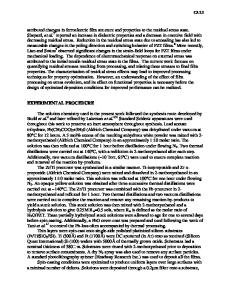Residual Stress in Sputtered Silicon Oxycarbide Thin Films
- PDF / 182,482 Bytes
- 6 Pages / 432 x 648 pts Page_size
- 63 Downloads / 311 Views
Residual Stress in Sputtered Silicon Oxycarbide Thin Films Ping Du1, I-Kuan Lin1,2, Yunfei Yan1 and Xin Zhang1 1 Department of Mechanical Engineering, Boston University, Boston, MA 02215, U.S.A. 2 Global Science & Technology, Greenbelt, MD 20770, U.S.A. ABSTRACT Silicon carbide (SiC) has received increasing attention on the integration of microelectro-mechanical system (MEMS) due to its excellent mechanical and chemical stability at elevated temperatures. However, the deposition process of SiC thin films tends to induce relative large residual stress. In this work, the relative low stress material silicon oxide was added into SiC by RF magnetron co-sputtering to form silicon oxycarbide (SiOC) composite films. The composition of the films was characterized by Energy dispersive X-ray (EDX) analysis. The Young’s modulus and hardness of the films were measured by nanoindentation technique. The influence of oxygen/carbon ratio and rapid thermal annealing (RTA) temperature on the residual stress of the composite films was investigated by film-substrate curvature measurement using the Stoney’s equation. By choosing the appropriate composition and post processing, a film with relative low residual stress could be obtained. INTRODUCTION Silicon-based ceramics (silicon oxide, silicon nitride, silicon carbide and their composites) are important structural and electronic materials for various applications in semiconductor and microelectromechanical systems (MEMS) [1]. Among these applications, mechanical properties such as modulus, hardness and residual stress play key roles to determine the device performances and structural reliability [2-4]. Typically, these ceramics can be fabricated by plasma-enhanced chemical vapor deposition (PECVD) [5] or magnetron sputtering [6] techniques. However, PECVD inevitably introduces a certain amount of hydrogen due to the precursors [7], therefore sputtering was used in this work. The thin film materials may have different properties from their bulk counterparts. Residual stresses, usually induced during the film formation, may have negative effects in thin-film processing: excessive compressive stress can result in film buckling and delamination, whereas excessive tensile stress may lead to film cracking [8]. In either case, residual stresses may damage the structures or reduce their service lifetime. Therefore, it is of vital importance to identify a reliable technique to minimize the residual stress in a controlled manner during the fabrication of MEMS. In our previous study on co-sputtered silicon oxynitride films, we showed that the composition of oxygen and nitrogen had a strong influence on the mechanical properties of the composite films [9]. Both the Young’s modulus and hardness increased with increasing nitrogen content in the composite films. In this work, we extend the material to silicon carbide, which is considered as a promising structural material with high strength at elevated temperatures [10, 11]. The distinct response of residual stresses in sputtered oxides and carbides
Data Loading...








